Categories
Archives
Day 2 of the IPTC Autumn Meeting 2019 was just as busy as Day 1: we heard from the IPTC NewsCodes Working Group, the AI Expert Group, and the News Architecture Working Group including updates on IPTC’s work on trust and credibility projects. We also had updates from the Video Metadata Working Group, an update on IPTC’s Rights work, and news from the Sports Content Working Group. Phew!
Jennifer Parrucci from the New York Times, lead of the IPTC NewsCodes Working Group, introduced IPTC NewsCodes and discussed recent progress, including cleaning up large parts of the Media Topics vocabulary. The Working Group also announced new language translations coming very soon: Portuguese and Brazilian Portuguese are ready, Chinese is almost ready, and some other language versions are in progress.
We also had an interesting and productive discussion about the workflow and process around Media Topics translations. As the team adds and retires terms and definitions, how should translations be managed? Should we not publish changes until we have translations in all languages? Or should there be a core of languages that require translations? Should we publish interim versions with un-synced changes and less frequent “stable” versions of Media Topics including all translations? We are having success using GitHub issues to manage regular changes to the taxonomy: can technology also help in managing the translation process and if so, which tools? Many ideas and thoughts were shared, including the perspectives of many member organisations who already work across multiple languages.
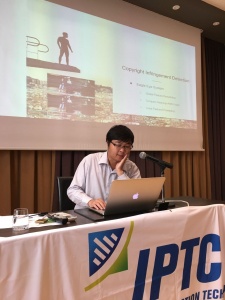
Tao Chen, VP of Machine Learning at 500px and lead of the new AI Expert Group, gave a great overview of the latest developments in AI affecting the media industry. From practical developments, like removing backgrounds from stock images, detecting copyright infringement and assessing the commercial potential of images, to the dangers of face swapping apps and a potential future of completely generated images that feature no real human beings, we learned a lot about how AI affects us today and tomorrow. We are building up the AI Expert Group to become the place where media technologists can go to learn the latest on AI and Machine Learning issues, apply the latest techniques in the media industry, and share ideas with their peers. If you’re a member and not yet involved, please talk to Tao or Brendan to get started.
Next up, Brendan Quinn spoke about IPTC’s recent work with the Journalism Trust Initiative and The Trust Project, on mapping their “trust indicators” to IPTC standards (particularly NewsML-G2) so news providers can show how they comply with trust criteria. Look out for some announcements about this work in the next few weeks. Then Dave Compton of Refinitiv, lead of the News Architecture Working Group gave an update on recent work on NewsML-G2, including the trust and credibility work, a NewsML-G2 2.28 errata release fixing some small typo errors, updates to the NewsML-G2 Guidelines and the NewsML-G2 Specification documents, work on making local extensions to Media Topics, and future work, including looking at how to represent auto-generated content, and better alignment with ninjs (see Monday’s wrap-up post for more on our recent ninjs updates).

After lunch, Pam Fisher of The Media Institute at University College London spoke about her project to build a read/write API that maps metadata between various video formats. We will link to a demo as soon as it is available. Pam also discussed “compact video signatures”, part of MPEG7, which are being used to make content fingerprints for video content, used for infringement detection and content matching.
Pam’s talk was very relevant to the next discussion by Michael Steidl, lead of the Video Metadata Working Group updating on recent progress. The Working Group has been looking at new video APIs and understanding how IPTC members and others are using video metadata in their work, either with or without IPTC Video Metadata Hub.
In the afternoon Michael Steidl presented again with an update on his work with W3C’s ODRL group which impacts on RightsML. Johan Lindgren presented in lieu of Paul Kelly, new Lead of the Sports Content Working Group, giving an update on the Working Groups efforts to interview IPTC members and others about their use of sports data and to position SportsML and our work on SportsJS in the context of the news and media industry.
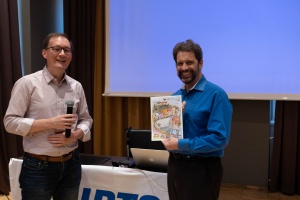
Finally we bade farewell to Stuart Myles, outgoing Chair of IPTC. We presented Stuart with a small token of our thanks for chairing the Board of Directors of IPTC since 2014, and has been involved with IPTC as a delegate since 1999! We will definitely miss his contributions, intelligence, common sense and enthusiasm, and we hope to see him involved with IPTC again in the future in some way.
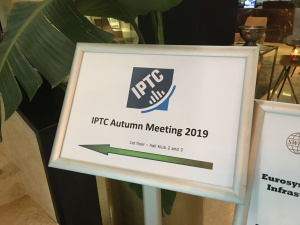 We are now back after a stimulating and entertaining IPTC Autumn Meeting in beautiful Ljubljana, Slovenia last week!
We are now back after a stimulating and entertaining IPTC Autumn Meeting in beautiful Ljubljana, Slovenia last week!
Thanks very much to Aljoša Rehar from IPTC member Slovenska tiskovna agencija (STA) for inviting us and helping out so much with the organisation, along with his colleague Marjana Polajnar and with support from Marko Grobelnik from another IPTC member organisation in Slovenia, the Josef Stefan Institute.
Over three days, we heard presentations from all IPTC Working Groups, the new AI Expert Group and the 2019 IPTC Annual General Meeting. We also heard presentations from invited startups and research projects such as the Content Personalisation Network from Digital Catapult UK and Slovenian projects EventRegistry, NewsMapper, Embeddia, Finspektor and more. Look out for our detailed post about Wednesday afternoon’s session for more about our invited speakers.
On Monday, Brendan Quinn, Managing Director of IPTC gave an introduction to the event and all attendees introduced themselves. We had a great turnout with members coming from all over Europe, Asia and both coats of the US. Brendan also gave an update on recent work of the IPTC Board and some decisions that are coming soon.
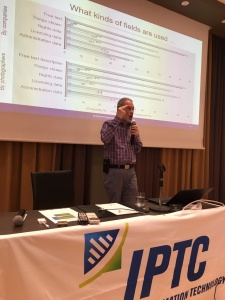
Monday’s focus was on both Photo Metadata and JSON standards. We heard from Michael Steidl, Lead of the Photo Metadata Working Group who gave an update on the recent work of the group, including the Photo Metadata Conference 2019 in Paris, recent work with Google, our latest Photo Metadata Survey, and exciting new work on introducing an Image Region capability to the IPTC Photo Metadata Standard, which will let photographers and image creators annotate specific areas of an image with any metadata fields, such as naming each person in an image exactly; identifying products, brands, logos, barcodes or other objects in an image, identifying composite images correctly, and allowing AI annotations to be embedded in the image file rather than distributed in a separate file alongside the image.
Johan Lindgren, who has recently moved from leading the Sports Content Working Group to now leading the News in JSON working group, spoke about the recent work on reviving the group. We are now meeting every two weeks like the other working groups, and plan to make many changes to our main JSON standard ninjs in the coming months. Johan presented an overview of how IPTC members are currently using JSON in their news distribution work, either based on ninjs or using their own formats. Based on change requests received in out GitHub project, the working group identified some “quick wins” that we could easily add to ninjs, and so Johan proposed ninjs 1.2 to the Standards Committee. Johan also showed recent work on a new ninjs User Guide to replace the pages at dev.iptc.org, and on a test suite so we know changes we make to the ninjs schema will be compatible with previous work and not introduce any errors.
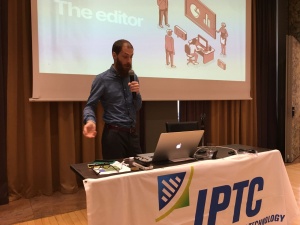
Day 1 ended with a presentation of the Content Personalisation Network project from Luca and Anthony from Digital Catapult in the UK. The work on tailoring content for users based on metadata is very relevant to our members and we hope to be able to work a lot more with the Digital Catapult team in the future.

Day 1 ended with a group dinner in a restaurant at Ljubljana Castle, overlooking the beautiful Old Town. After a day sitting inside it was great to have some good exercise walking up the steep hill to get there, and we were rewarded with some great local food.
Stay tuned for more updates from the Ljubljana meeting. If you couldn’t make it to Ljubljana, why not attend our next event in Tallinn, Estonia in May 2020?
A clear majority of professional photo businesses in Europe and North America find IPTC photo metadata highly relevant to their business. That is the message received by IPTC from its 2019 photo industry supplier survey.
According to survey results, eight out of ten photo supplier companies say that data describing images and supporting searches by users is most relevant. Eight out of ten photographers say that metadata to express ownership and usage rights is most important.
These trends are shown by a survey among photo professionals conducted by IPTC, the maker of the industry standard for embedding descriptive, rights information and administrative metadata into images. The 2019 IPTC Photo Metadata Survey results were made public on 14 August 2019 and can be downloaded from the iptc.org website.
“We know that taking the time to apply photo metadata is an investment by photo businesses, so it’s good to see that they get a return,” said Michael Steidl, lead of IPTC’s Photo Metadata Working Group. “Still, we are pleasantly surprised by the importance that photo businesses give to metadata.”
The survey investigated how and why IPTC photo metadata are used in 2019, and more than 100 supplier companies and photographers from many European countries and the USA participated. Most respondents to the supplier survey are companies active in the stock images business, but IPTC also received responses from companies dealing with news photos, cultural heritage images and video footage. The primary business areas of photographers are stock images and public relations photos.
The main reason for applying descriptions of what is depicted in an image are for supplier companies business needs, primarily to help users or customers to find an image they are looking for. Businesses apply rights and licensing data primarily because of legal requirements, but also to protect their companies revenue streams. Administrative data are added to satisfy customer needs.
For photographers, rights are of critical importance
The use of rights data by photographers is more driven by their own business needs than by legal requirements. As photographers are the first party in the supply chain of images they have a high interest to claim who is the creator and the first copyright owner of each creative work. Applying descriptions of the image is driven by customer needs and business needs of photographers. Why administrative data is applied comes also from their business needs and much less from customer needs compared to supplier companies.
IPTC photo metadata – used since 1995
The IPTC photo metadata standard originated in 1995 when Adobe and other makers of image software adopted the IPTC Information Interchange Model (IIM) standard for the panels with fields describing what an image shows, providing the name of the photographer, stating copyright and usage terms, and sharing instructions and more administrative information. In 2005 IPTC published its first Photo Metadata Standard covering fields used by photo professionals and expressed by the IIM format and the then-new XMP format. The IPTC fields were substantially extended in 2008 and since then the standard has been continuously maintained by IPTC, the global standards body of the news media.
For more information, download the full analysis of supplier survey results as a PDF.
Recently conversations on Twitter and various blogs and news sites have reported on Facebook’s use of IPTC embedded photo metadata fields to “track users”. (Reddit.com: “Facebook is embedding tracking data inside the photos you download”, The Australian: “Facebook pics tracking you”, Forbes: “Facebook Embeds ‘Hidden Codes’ To Track Who Sees And Shares Your Photos”, Financial Express: “Beware! Facebook embeds tracking data inside photos you download”).
As the creators and maintainers of the IPTC Photo Metadata Standard, we want to clarify a few points and share our own analysis of the situation.
In Spring 2019, IPTC’s Photo Metadata Working Group conducted our latest round of tests regarding how various social media platforms deal with metadata embedded in uploaded and shared images. The 2019 test results show how Facebook treats image metadata: in IIM and EXIF formats, a few fields are retained related to claiming rights while all others are removed, and in the XMP format all fields are removed.
While this was a small improvement compared to the previous IPTC test in 2016 when all Exif fields were removed, we did not rate Facebook with a “green dot” showing compliance with IPTC standards, as removing metadata embedded by the owner of an image contradicts IPTC’s strong support for keeping metadata persistent.
In addition, in both the 2016 and 2019 tests the Working Group found that two fields in the IIM format do indeed appear to be given values populated by Facebook.
IPTC looks at the facts
IPTC provides a reference image for each version of its Photo Metadata Standard which contains a test value for every specified metadata field. This makes it easy to test which fields are removed or modified.
The reference image of the 2017.1 version of the standard was uploaded to Facebook by the Working Group member David Riecks and it can still be seen here. Next the group used the IPTC’s Get IPTC Photo Metadata website tool for retrieving embedded metadata of most of the images shown on the web. Anyone can use this tool: simply fill the URL of the image into the site’s form and click to see all the metadata embedded in the image.
This test was performed using the URL of the IPTC reference image uploaded to Facebook and the result was shown instantly:
- Embedded metadata fields in the IIM format related to rights were retained: Creator, Creator Job Title, Copyright Notice, Credit Line, Source and Description Writer.
- All embedded metadata using the XMP format were removed by Facebook.
- The Creator and the Copyright Notice in the Exif format were also retained.
- The Instructions field and the Job Id field in IIM show values significantly different from what had been uploaded. The IPTC Working Group assumes these values were inserted by Facebook:
- The value of the Instructions field starts with FBMD. The IPTC Working Group retrieved this image using “Save As…” and another Facebook user uploaded it to his account. Result: the value was not changed during the second upload to Facebook. These results were shown for the re-uploaded image.
- The value of the Job Id fields looks like a unique identifier. If an uploaded image is downloaded using the Save As function and then uploaded by another Facebook user this field contains a different value.
- The IPTC Working Group searched for any documentation of these inserted values but found no specification or statement from Facebook. There have been, however, many guesses and assumptions by users and developers.
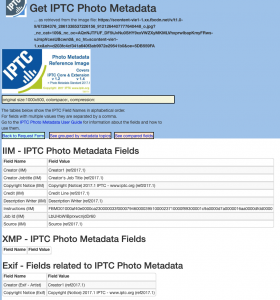
Using the Get IPTC Photo Metadata site anybody can check what Facebook values were applied to her or his photo. As a user, you can find Facebook image URLs by clicking on the image on the Facebook site and using the “Copy image address” or the “Inspect” or “Inspect Element” function of your web browser, you should then see the URL.
IPTC’s summary
IPTC tests showed when a Facebook member uploads an image to the Facebook system it removes a lot of fields, keeps only a few related to rights and replaces or adds values to the Job Id and the Instructions fields. The role of these values is not publicly documented by Facebook, so they are currently the subject of significant speculation.
IPTC makes no assumptions about what the metadata values are used for, but Facebook appears to keep the value of the Instructions field constant even when the image is re-uploaded by another user. The Job ID field on the other hand changes with each separate upload.
Our recommendations are that all embedded metadata values should be retained by platforms and that no platform should be overwriting user metadata.
IPTC’s 2019 Social Media Platforms survey also looked at the metadata usage of other major social media platforms. Interested parties can find more information at Social Media Sites Photo Metadata Test Results 2019.
Technical notes
The example metadata values embedded into the 2017.1 reference image can be checked by going to https://getpmd.iptc.org and clicking on the green button in Option A labeled Get Photo Metadata of Web Image. No image URL is required, as by default the metadata of this reference image is retrieved and displayed.
For those interested in the technical details of embedded photo metadata, the technical formats IIM and XMP are introduced in the IPTC Photo Metadata User Guide, including a look under the hood of image files.
Home and away teams
alignment attribute.Pre-game actions
<actions>
<action sequence-number="1" team-idref="team_9572" type="esacttype:remove" comment="Nuke"></action>
<action sequence-number="2" team-idref="team_6134" type="esacttype:remove" comment="Inferno"></action>
<action sequence-number="3" team-idref="team_9572" type="esacttype:choose" comment="Cache"></action>
<action sequence-number="4" team-idref="team_6134" type="esacttype:choose" comment="Train"></action>
<action sequence-number="5" team-idref="team_9572" type="esacttype:remove" comment="Overpass"></action>
<action sequence-number="6" team-idref="team_6134" type="esacttype:remove" comment="Dust2"></action>
<action sequence-number="7" type="esacttype:remaining" comment="Mirage"></action>
</actions>
Statistics for eSports teams, players and tournaments
scoping-label on outcome-totals in SportsML:<team-stats score="16" event-outcome="speventoutcome:win"> <outcome-totals scoping-label="T" wins="4" /> <outcome-totals scoping-label="CT" wins="12"/></team-stats><player-stats> <rating rating-value="1.11"/> <stats> <stat stat-type="esstat:kills" value="15" /> <stat stat-type="esstat:headshot" value="6" /> <stat stat-type="esstat:assist" value="4" /> <stat stat-type="esstat:flashassist" value="2" /> <stat stat-type="esstat:deaths" value="11" /> <stat stat-type="esstat:KAST" value="78.3" /> <stat stat-type="esstat:ADR" value="68.4" /> <stat stat-type="esstat:FKdiff" value="0" /> </stats></player-stats>stat construction with stat-type and value we can handle any type of statistic.esstat: and esacttype: in these examples do not currently exist in the IPTC NewsCodes catalog but could easily be set up if needed. It might be necessary to have different prefixes for different type of eSports games. But that would require some more investigation.
Last week’s 2019 IPTC Photo Metadata Conference was again hosted in association with the CEPIC Congress. This year’s conference was held in a slightly rainy Paris but at least that meant that we didn’t mind staying indoors in late May.
The event kicked off with an introduction from event chair Stéphane Guérillot from AFP, who is also on the Board of IPTC and Chair of the IPTC Standards Committee. The theme of the afternoon was “putting IPTC metadata to work for your image collections” and the emphasis on practical outcomes was a constant refrain.
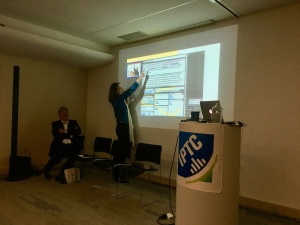
The first panel was around the question of “do we still need IPTC Photo Metadata?” Michael Steidl, lead of the IPTC Photo Metadata Working Group started off by presenting results from the IPTC Photo Metadata surveys that the Working Group has undertaken earlier this year. Lúí Smyth from Shutterstock showed how metadata has helped them to organise millions of photos from thousands of sources. Isabelle Wirth, photo editor at AFP discussed how the agency uses IPTC Photo Metadata along with other IPTC standards such as News Codes and NewsML-G2 to make content searchable and shareable for their clients. And independent photographer and 3D photogrammetry expert with Deep3D, Simon Brown, explained how metadata was crucial for creating 3D views of sunken shipwrecks via tens of thousands of still photographs and some innovative software. In Simon’s words: “For more than one 3D project, projects with multiple contributors, or projects conducted over a longer period of time, IPTC entry becomes mandatory.”
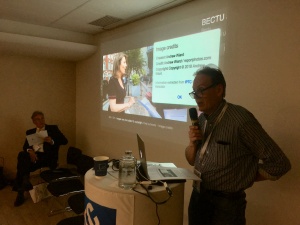
The next session examined how creating and editing IPTC Photo Metadata could be improved. Sarah Saunders representing CEPIC presented results from the IPTC Photo Metadata surveys of both image suppliers and software makers showing that metadata usage has grown in sophistication but still varies greatly between independent photographers and large companies. Andrew Wiard, photographer and member of the British Press Photographers’ Association, spoke with passion about how we could improve the handling of photo metadata once it leaves the photographer’s desk, a constant goal of the Photo Metadata Working Group and which will form part of our work plan for the rest of 2019. Mayank Sagar from Image Data Systems showed some exciting tools with videos showing how their AI algorithms can detect objects from luggage and handbags for commuters to brands and logos on advertisements in sports footage, and talked about the current limits of AI classification and future issues such as how to handle artificially synthesised images. Andreas Gnutzmann of popular photo management software Fotoware showed how their system is moving to the cloud, putting metadata at its core even more than previously.
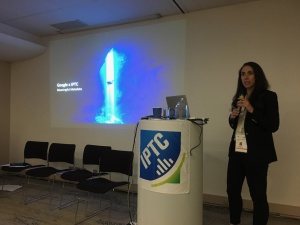
The third session looked at the end-user side and how the industry can benefit from photo metadata. Brendan Quinn of IPTC presented the Photo Metadata Crawler project, examining how news publishers around the world are embedding photo metadata in the images used on their sites. Michael Steidl showed results of the Photo Metadata Working Group’s updated analysis of social media systems and sharing platforms, which will be shared through an IPTC news article in the coming months. And Anna Dickson of Google gave us an update on her history working with images as photo editor at Huffington Post and Dow Jones among others, and discussing how Google are working with metadata and the IPTC, including our shared challenges of encouraging more site owners to publish embedded metadata so that it can be picked up by Google Search and other services. At the event, Google also announced some very interesting features that are currently in the pipeline.
Michael Steidl and Stéphane Guérillot closed out the event talking about the work the the IPTC Photo Metadata Working Group would be undertaking this year as a result of the discussions and of the survey results.
All slides from the day are available in PDF format from the event page, both to IPTC members and non-members.
Key findings from the Photo Metadata surveys will be shared in future news posts, so please watch this space for updates.
More information about the Google presentation and their proposed new features around image metadata is available to all IPTC members who have joined the Photo Metadata Working Group.
Thanks to all the speakers, to CEPIC for their assistance in hosting the conference, and to everyone who attended for making the event such a success!
At the IPTC Spring Meeting in Lisbon, the IPTC Standards Committee signed off on version 3.1 of SportsML.
Updates include:
round-numberattribute added tobaseEventMetadataComplexType- Added
events-discardedtooutcomeTotalsComplexTypeandresult-statustobase3StatsComplexTypeto support events where players or teams can discard some of their results. - Fixed examples to use the correct qcodes
nprt:given,nrol:shortetc for names - Corrected description of
distanceinactionAttributes
You can download the ZIP Package of SportsML 3.1 with XML Schemas and documentation included.
Development of SportsML is open to collaboration. Your feedback on the SportsML Users Forum is welcome!
We’re excited that the biggest week in the photo metadata calendar has arrived – the IPTC Photo Metadata Conference 2019 will be held in Paris this Thursday, 6 June.
We are looking forward to hearing from some IPTC members: Andreas Gnutzmann from Fotoware, Lúí Smyth from Shutterstock, Isabelle Wirth of Agence France Presse and Michael Steidl, Chair of the Photo Metadata Working Group and honourable member of IPTC. Stéphane Guerrilot, CEO of AFP Blue will be chairing the event.
We will also be hearing from independent photographer Andrew Wiard representing the British Press Photographer’s Association (BPPA), plus Anna Dickson, Visual Lead, Image Search at Google attend, bringing her expertise as one of Google’s experts on images but also with a history leading photography teams at Dow Jones and Huffington Post. Mayank Sagar from Image Data Systems will be speaking about the latest developments in automatic image tagging, and Simon Brown of Deep3D will look at the photographer’s view around embedding metadata.
Michael Steidl and Sarah Saunders will be presenting the results of the 2019 Photo Metadata Survey, where we have obtained the views of image creators, publishers and software makers regarding embedded image metadata.
Brendan Quinn, Managing Director of IPTC will be presenting the IPTC Photo Metadata Crawler which looks at usage of embedded photo metadata among news publishers.
We’re looking forward to analysing the world of photo metadata from the perspective of image creators and editors, software makers, publishers, search engines and end users.
There are still some tickets available, so please join us! Attendance is free for CEPIC Congress attendees, but if you just want to come for the IPTC event on Thursday afternoon you can register using this form for €100 + VAT.
See you there!
This post is part of a series about the IPTC Spring Meeting 2019 in Lisbon, Portugal. See day 1 writeup and the day 2 writeup.
Day 3 of the Lisbon meeting was all about metadata and controlled vocabularies, rights, and a look to the future of IPTC’s work plan.

We started with an update from Jennifer Parrucci, Senior Taxonomist at New York Times and lead of the IPTC NewsCodes Working Group, who gave an update of the group’s activities over the past six months. We have been focussing on updating our core subject taxonomy Media Topics, including updates to term labels and definitions, and also integrating and updating mappings to Wikidata entities that were kindly provided by Thad Guidry from the schema.org community.
Integrating Wikidata mappings was an interesting challenge as we didn’t always have good mappings, for example for “arts, culture, entertainment and media” there is no Wikidata entity that is broad enough to encompass all of those terms. But for the leaves of our tree, most terms had mappings, and for those that didn’t we will be suggesting new terms in Wikidata to accommodate them. We will also look at updating the mappings from Wikidata back to Media Topics now that we have updated the mappings in the other direction. Brendan Quinn presented some new tools used for managing NewsCodes internally, plus a new web tree browser view of Media Topics which will be launched very soon.
Translating Media Topics is another hot issue, with a recent contribution from the Swedish media that is now available as a Swedish language version of Media Topics. We have made it easier to find the language translations in the NewsCodes browser, and have also added some new terms that were suggested by the Swedish media consortium that will be using the new Swedish translation of Media Topics as their categorisation system for sharing content in the future. We realise that nearly ten years after moving from SubjectCodes to Media Topics as the standard IPTC subject classification, we still don’t support as many languages in Media Topics as we do in SubjectCodes so we want to make it as easy as possible to perform translations. Our discussion was based on the useful idea that anything with an existing translation in SubjectCodes can be directly taken into a Media Topics translation, and we can use the SubjectCode and Wikidata mappings to extract suggested term to get a translation team started. We have interest in creating Media Topics translations in Portuguese (for both Portugal and Brazil) and Chinese. If you are interested in helping with translations, please let us know.
Johan Lindgren from TT in Sweden spoke about the project that led to the Swedish translations and also discussed how they are approaching handling entities (names and organisations). This led to a wider discussion led by Stuart Myles of how to handle lists of entities and whether IPTC should be working on a standard or a best practice document in that area. We also discussed the idea of a taxonomy for describing images in a stylistic way (such as “happy”, “blue”, or “outdoors”) as opposed to describing the content. Such a standardised controlled vocabulary could be useful to image libraries and AI classification engines. This is an area of active work for us and more information will be available in the coming months. If you want to help, talk to us!
Invited guest Carlos Amaral from local company Priberam demonstrated their text mining and visualisation system created in partnership with Deutsche Welle and other broadcasters for use in browsing stories according to subject, image, extracted entities and keywords.
Stéphane Guérillot from AFP presented his new API for retrieving news content, which led to more discussion of whether IPTC should be standardising an API that could be used by multiple news providers to share their content.
Michael Steidl spoke on RightsML and Blaise Galinier from BBC talked about their current project looking at viewing news content based on rights. Two key insights from Blaise’s talk: Firstly, any demonstration of what is or isn’t usable is always based on the particular user and the context in which they want to use a piece of media. Also, it’s not enough to show a journalist what they can and can’t use; they need to know why a piece of content is “red” “green” or “amber”.
Everyone had a great time at this year’s 2019 Spring Meeting, we’re already planning the next one in Ljubljana, Slovenia in October. Members: please save the dates 14 – 16 October 2019. If you’re not a member but you would like to present at the meeting, please get in touch!
This post is part of a series about the IPTC Spring Meeting 2019 in Lisbon, Portugal. See day 1 writeup and the day 3 writeup.
Tuesday was our biggest day in terms of content and also in terms of people! We had 40 people in the meeting room which was a tight squeeze, thanks to everyone for your understanding!

The topic focus for Day 2 was Photo and Video, so it was natural that the day was kicked off by Michael Steidl, lead of the IPTC Photo and Video Working Groups. As we had a lot of new members and new attendees in the audience, Michael gave an overview of how IPTC Photo Metadata has come to where it is today, used by almost all photography providers and even used in Google Image Search results (see our post from last year on that subject). The Photo Metadata Working Group is currently conducting a survey of Photo Metadata usage across publishers, photo suppliers (such as stock photo agencies and news wires), and software makers. Michael gave a quick preview of some of the results but we won’t spoil anything here, you will have to wait for the full results to be revealed at the 2019 IPTC Photo Metadata Conference in Paris this June. Brendan Quinn also presented a status report on the IPTC Photo Metadata Crawler which examines usage of IPTC Photo Metadata fields at news providers around the world. This will also be revealed at the Photo Metadata Conference.
Next, invited visitors Ilkka Järstä and Marina Ekroos from Frameright presented their solution to the problem of cropping images for different outlets, for example all of the different sizes required for various social media. They embed the crop regions using embedded metadata which is of great interest to the Photo Metadata Working Group, as we are looking at various options for allowing region-based metadata to cover not only an image as a whole but a region within an image, in a standardised way.
We had a workshop / discussion session on the recently ratified EU Copyright Directive which will impact all media companies in the next two years. Voted through by the European Parliament this month after intense lobbying from both sides, it could easily be bigger than GDPR, so it’s important for media outlets around the world. Discussion included how and whether IPTC standards could be used to help companies comply with the law. No doubt we will be hearing more about this in the future.
Michael then presented the Video Metadata Working Group‘s status report, including promotional activities at conferences and investigations to see what use cases we can gather from various users of video metadata amongst our members and in the wider media industry.
Then Abdul Hakim from DPP showed a practical use of video metadata in the DPP Metadata for News Exchange initiative which is based on NewsML-G2. An end-to-end demonstration of metadata being carried through from shot planning through the production process all the way to distribution via Reuters Connect. See our blog post about the Metadata for News Exchange project for more details.
Then Andy Read from BBC presented the BBC’s “Data flow for News” project, taking the principles of metadata being carried through the newsroom along with the content, looking at how to track the cost of production of each item of content and also its “audience value” across platforms to calculate a return on investment figure for all types of content. Iain Smith showed the other side of this project via a live demonstration of the BBC’s newsroom audience measurement system.
After lunch, Gan Lu and Kitty Lan from new IPTC member Yuanben presented their approach to rights protection using blockchain technology. Yuanben run a blockchain-based image registry plus a scanner that detects copyright infringements on the web. Using blockchain as proof of existence has been around for a while but it’s great to see it being used in such a practical context, very relevant for the media industry.
Lastly, another new member Shutterstock was represented by Lúí Smyth who gave us an overview of Shutterstock’s current projects relating to large-scale image management: they have over 260 million images, with over 1 million images added each week! Shutterstock are using the opportunity of refreshing their systems to re-align with IPTC standards and to learn what their suppliers, partners and distributors expect, and we look forward to helping them tackle shared challenges together.
Categories
Archives
- December 2025
- November 2025
- October 2025
- September 2025
- August 2025
- July 2025
- June 2025
- May 2025
- April 2025
- March 2025
- February 2025
- January 2025
- December 2024
- November 2024
- October 2024
- September 2024
- August 2024
- July 2024
- June 2024
- May 2024
- April 2024
- March 2024
- February 2024
- December 2023
- November 2023
- October 2023
- September 2023
- August 2023
- July 2023
- June 2023
- May 2023
- March 2023
- February 2023
- January 2023
- December 2022
- November 2022
- October 2022
- September 2022
- August 2022
- July 2022
- June 2022
- May 2022
- April 2022
- March 2022
- February 2022
- January 2022
- December 2021
- November 2021
- October 2021
- September 2021
- August 2021
- July 2021
- June 2021
- May 2021
- April 2021
- February 2021
- December 2020
- November 2020
- October 2020
- September 2020
- August 2020
- July 2020
- June 2020
- May 2020
- April 2020
- March 2020
- February 2020
- December 2019
- November 2019
- October 2019
- September 2019
- July 2019
- June 2019
- May 2019
- April 2019
- February 2019
- November 2018
- October 2018
- September 2018
- August 2018
- July 2018
- June 2018
- May 2018
- April 2018
- March 2018
- January 2018
- November 2017
- October 2017
- September 2017
- August 2017
- June 2017
- May 2017
- April 2017
- December 2016
- November 2016
- October 2016
- September 2016
- August 2016
- July 2016
- June 2016
- May 2016
- April 2016
- February 2016
- January 2016
- December 2015
- November 2015
- October 2015
- September 2015
- June 2015
- April 2015
- March 2015
- February 2015
- November 2014